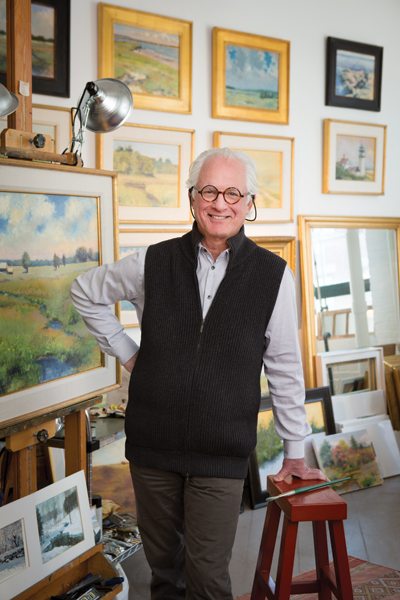Five Questions: Jeremiah Eck
April 22, 2017
Boston-based architect, painter, and teacher Jeremiah Eck offers his perspective on the elements of good design.
Text by Kiener Photography by John Soares
 Boston-based architect, painter, and teacher Jeremiah Eck offers his perspective
Boston-based architect, painter, and teacher Jeremiah Eck offers his perspective
on the elements of good design.
1. You have said that beauty is not solely in the eye of the beholder. What do you mean?
I think we want to deny that beauty can be objectified, but there are rules about proportion, massing, and functionality—the things that add up to a good building. I once had an employee who said he didn’t want to make beautiful buildings, just good ones. There is something to that. People want to make something beautiful, but when something is well done in all ways, it is beautiful. Rather than concentrating strictly on the notion of what defines beauty, which is somewhat subjective, I think it’s more important to define what is good. Good demands a certain amount of discipline; it requires that we pay attention to rules.
2. Where does good design begin?
A house always begins with the site; it’s the most critical thing. The older I get—and I don’t want to sound corny here—the more I think how sacred this act of building a house is. I can imagine cultures in the past held some kind of ceremony before they started building a house. You’re digging a hole in ground that probably has not been disturbed for thousands of years, and you should think carefully about how you do that. We don’t, for example, change the flow of water on the land. We don’t go in with an excavator and plow the earth and cut down the trees. If you look for what it is about the site that makes it special, your home will feel that much more special. You need to look at fundamental things: the topography, the subtle lay of the land, where is the vegetation, where is the wind coming from? You are trying to make this built object feel like it belongs to this piece of land. If you begin with these fundamentals, you are off to a good start.
3. How should the “face” of a home relate to the interior?
It should reflect what is going on inside instead of being imposed on a plan. For example, people may say, “I want a French chateau-style house,” even though the interior plan is completely unsuitable for a French chateau. The plan should come first and needs to reflect function. Details such as chimneys, columns, and trellises need to spring from the whole. You wouldn’t put Ionic columns on a woodsy cabin porch; a house’s details are like exclamation points to what you have already discovered. It is like finishing a sentence with flair.
4. You are an accomplished landscape painter. How does this inform your work as an architect?
I started painting one day a week in the late 1980s. I soon discovered that painting reinvigorated me by helping me make intuitive judgments faster, and intuition leads to good design. I actually retrained my brain. I also found that painting is related to architecture in that when you look at a view, you are choosing something for composition and value. If you get those elements right, a painting can’t fail. That is also true in architecture. Painting is also a great antidote to burnout!
5. You’ve described color as “an often overlooked” part of architecture?
When you look at a house, you are not just looking at a house; you are looking at the colors of the house in relation to the colors in the landscape. They are not disassociated. You can take the view that they don’t need to be related at all, like architect Richard Meier has done, that every house needs to be white, no matter what landscape or environment it is in. Or you can take the view that there are hints in the landscape—in the color of the soil, the color of the vegetation, the sky, where the light enters the house throughout the day—that should be reflected in the architecture in some way. If we are going to say that the house has to be well sited, how can we not include the color of the house? Not everyone agrees with me on this, but I think colors are an interesting part of how one sites a house. | Eck|MacNeely Architects, Boston, (617) 367-9696, eckmacneely.com
Eck|MacNeely Architects, Boston, (617) 367-9696, eckmacneely.com
Share
![NEH-Logo_Black[1] NEH-Logo_Black[1]](https://b2915716.smushcdn.com/2915716/wp-content/uploads/2022/08/NEH-Logo_Black1-300x162.jpg?lossy=1&strip=1&webp=1)









You must be logged in to post a comment.